Looking to improve English skills and gain more subject knowledge then the best resources that you can use here is Samacheer Kalvi 10th English Solutions for Poem Chapter 5 The Secret of the Machines Questions and Answers.
In the Samacheer Kalvi 10th English Guide for Chapter 5 The Secret of the Machines textbook solutions, subject experts covered all types of questions and answers related to the topics, quick notes, summary, solved & unsolved exercises, etc. If you are planning to prepare Chapter 5 The Secret of the Machines via textbook, then you’re suggested to go with this Samacheer Kalvi 10th English Book Solutions Questions and Answers PDF for better understanding and preparation.
Tamilnadu Samacheer Kalvi 10th English Solutions Poem Chapter 5 The Secret of the Machines
English Subject experts who are having max years of experience prepared this Tamilnadu State Board Solutions for 10th English Poem Chapter 5 The Secret of the Machines Questions and Answers. They have explained all the topics covered in the board prescribed latest syllabus in a simple way to understand easily. So, students can prepare Chapter 5 English from this Samacheer Kalvi 10th English Book Questions and Answers PDF. Download the Tamilnadu State Board 10th English Chapter 5 The Secret of the Machines Workbook Solutions PDF by accessing the below links and learn properly for the final exams to score well.
The Secret of the Machines Textual Questions
A. Answer the following questions briefly.
The Secret Of The Machines Question 1.
Who does ‘we’ refer to in the first stanza?
(a) Human beings
(b) Machines
Answer:
(b) Machines
The Secret Of The Machines Poem Questions And Answers Question 2.
Who are the speakers and listeners of this poem?
Answer:
The speakers are the Machines which is the brain child of man. The listeners are the readers of this poem.
10th English Poem The Secret Of Machines Question 3.
What metals are obtained from ores and mines?
Answer:
The metals obtained from ores are iron ores and minerals from mines.
The Secret Of The Machines Poem Summary Question 4.
Mention a few machines which are hammered to design
Answer:
Pulley – Power lift, The Cutting Wedge, The Wheel and Axle are a few machines which are hammered to design.
The Secret Of Machines Figure Of Speech Question 5.
Mention the names of a few machines that run on water, coal or oil.
Answer:
Power Station, Pipeline transport, Water Heaters, Train, Car, Plane, Ship are a few machines that run on water, coal or oil.
10th English Poem The Secret Of The Machines Question 6.
Mention a few machines used for pulling, pushing, lifting, driving, printing, ploughing, reading, and writing etc.
Answer:
Pulling – Pulley, Winch, Elevator, Windlass, Pushing – Motor Engines, Lifting – Crane, „ Hoist, Driving – Car, Omnibus, Caravan, Printing – Typewriter, Computer printer, Fax machine, Ploughing – Tractor, Reading and Writing – Computer, Cellular Phones The above are a few machines used for pulling, pushing, lifting, driving, printing, ploughing, reading, and writing.
The Secret Of The Machines Memory Poem Question 7.
Are machines humble to accept the evolution of human brain? Why?
Answer:
The machines humble themselves only before God and not humble to accept the evolution, of human brain since they warn us to be humble and tell us about their power to wipe out mankind. (The poetic lines related with the answer to this question is not given in the textbook.)
10th Poem The Secret Of Machines Question 8.
What feelings are evoked in us by the machines in this poem?
Answer:
Pride and superiority are the feelings evoked in us by the machines in this poem. There is also the feeling of fear and perusal that no error in handling the machinery should take place.
10th English Unit 5 Poem Question 9.
‘And a thousandth of an inch to give us play:’
Which of the following do the machines want to prove from this line?
(a) Once Machines are fed with fuel, they take a very long time to start.
(b) Once Machines are fed with fuel, they start quickly.
Answer:
(b) Once Machines are fed with fuel, they start quickly.
The Secret Of Machines Questions And Answers Question 10.
“And now, if you will set us to our task,
We will serve you four and twenty hours a day!”
(a) Who does the pronoun ‘you’ refer to here?
(b) Whose task is referred to as ‘our task’ here?
(c) Open conditional clause is used in the given line. Why is the future tense ‘will set’ and ‘will serve’ used both in the ‘if clause’ and in the ‘main clause?’
(d) Do the machines serve us twenty four hours a day?
(e) Rewrite the given lines with the ending ‘365 days a year.’
Answer:
(a) ‘You’ refers to the industrialists and the people using the machines.
(b) The task to be performed for the industrialists by the machines is referred to as ‘our task’.
(c) The future tense ‘will set’ and ‘will serve’ is used both in the ‘if clause’ and in the ‘main clause’ to indicate surety and futurity.
(d) Yes, the machines serve us round the clock and non-stop the entire day.
(e) Some water, coal, and oil is all we ask,
And a thousandth of an inch to give us play, lend us your ear:
And now, if you will set us to our task,
We ’ll serve you three hundred and twenty four hours a year!
Additional Questions
The Secret Of Machines Poem Question 1.
Which stanza shows us that the machines have mastered almost all the common ”
human activities?
Answer:
We can pull and haul and push and lift and drive,
We can print and plough and weave and heat and light,
We can run and race and swim and fly and dive,
We can see and hear and count and read and write!
The Secret Of The Machines Poem Question 2.
Is there anything that the machines are incapable of doing?
Answer:
Machines cannot detect a lie. Besides, machines cannot emote nor comprehend feelings. Therefore, machines are incapable of loving, pitying or forgiving.
Secret Of Machines Poem Question 3.
What is the warning issued by the machines?
Answer:
We must accept the fact that our dependency on machines are increasing day by day. A . time will come when people will depend on a machine to wake them from sleep and then to put them back to sleep, walk and eat. If this really happens, life will be different, similar to a robotic life – without feelings, sympathy, pity, forgiveness and love.
Secret Of The Machines Question 4.
Which lines tell us that for every little input, the machines are able to provide constant, daily service to humans?
Answer:
Some water, coal, and oil is all we ask,
‘And a thousandth of an inch to give us play:
And now, if you will set us to our task,
We will serve you four and twenty hours a day!
The Secret Of The Machines Poem Pdf Question 5.
How did machines come to life?
Answer:
Machines had taken a long way before they came to life. First their basic raw building materials were dug out as iron ores from ore-beds and minerals from mines. After processing ores in the hot furnaces, metals were formed and every machine was given a specific shape by casting and hammering. This then followed a more accurate process which includes cutting and measuring and tooling.
The Secret Of The Machines Poem Figures Of Speech Question 6.
Can we really rely upon machines?
Answer:
No, we cannot always rely on machines as with people. Suddenly some simple apparatus will fail. If the machine is faulty, it can even go to the extent of killing us.
The Secret Of The Machines Questions And Answers Question 7.
Should we depend on machines?
Answer:
To an extent, we should depend on machines in transport, communication and education, which mostly get complicated. This is inevitable as we move further into a technological age of computers and increasing automation. We must accept the fact that our lives depend on machines day by day.
The Secret Of Machines Poem Summary Question 8.
What do machines symbolise?
Answer:
Machines symbolise man’s progress.
B. Write your favourite stanza from the poem and find the rhyming scheme.
Though our smoke may hide the Heavens from your eyes, a
It will vanish and the stars will shine again, b
Because, for all our power and weight and size, a
We are nothing more than children of your brain! a
C. Read the poem and find the Sines for the following poetic devices or write your own example.
Alliteration:
filed to fit; pull and push; print and plough; run and race; hide the heavens;
Own Example:
- The cat, clawing the couch is creating chaos.
- Michael made mellow music on the mike.
- Rudolph the red-nosed reindeer raced rapidly from the room.
Assonance:
Oil is all; pull and push; weave and heat; fly and dive
Own Example:
- mellow wedding bells
- crumbling thunder
- she bleats when she speaks
Personification:
Some water, coal and oil is all we ask We can pull and push and lift and drive Bui remember, please, the Law by which we live We are nothing more than children of your brain!
Own Example:
- Two Sunflowers Move into the Yellow Room.
- The popcorn leapt out of the bowl.
- The sun glared at me from the sky.
- The fire ran wild.
Simile:
Nil
Own Example:
- The flowers were as soft as thoughts of budding love.
- You are soft as the nesting dove.
- She hung her head like a dying flower.
- Her eyes are like the eyes of statues.
Additional Questions
Anaphora: Anaphora is the technique of repeating a specific word or phrase at the beginning of a line or passage. The repetition of a word can intensify the overall meaning of the piece. We were taken from the ore-bed and the mine,
We were melted in the furnace and the pit We were cast and wrought and hammered to design,
We were cut and filed and tooled and gauged to fit.
We can pull and haul and push and lift and drive,
We can print and plough and weave and heat and light,
We can run and race (jump) and swim and fly and dive,
We can see and hear and count and read and write!
Own Example
- Charles Dickens – It was the best of times, it was the worst of times, it was the age of wisdom, it was the age of foolishness, it was the epoch of belief, it was the epoch of incredulity, it was the season of Light, it was the season of Darkness, it was the spring of hope, it was the winter of despair.
- Winston Churchill – We shall fight in France, we shall fight on the seas and oceans, we shall fight with growing confidence.
- Martin Luther King Jr’s – “I have a dream that one day this nation will rise up and live out the true meaning of its creed: I have a dream that one day on the red hills of Georgia the sons of former slaves and the sons of former slave owners will be able to sit down together.
Answer each of the following questions in a paragraph of about 100 – 150 words.
Question 1.
Describe in your own words how the poem, The Secret of the Machines’ by Rudyard Kipling has an importance to current life.
Answer:
This poem written at the beginning of the twentieth century is about Industrialization. The poet starts by describing how the machines are created, wrought and taken from the ore-bed and mines. The only requirement for the machines is water, coal and oil. Further, Kipling enumerates the various skills of machines, such as pulling, carrying, pushing, lifting, driving, printing, ploughing, weaving, heating, lighting, running, racing, swimming, flying, diving, seeing, hearing, counting, reading and writing. Machines do. exactly as it is programmed.
These machines have no feelings and any wrong handling can be dangerous for they are just machines with power invented by humans. The first intention of the poem reveals the progress of machines which is indeed a good thing for mankind. They make many things easier and facilitate the work of the humans. The second purpose is to express that a machine can never replace a human-being, because a machine is devoid of feelings being the child of human brain.
Hence man has full control over it, dependent on humans. By choosing the headline, “The secret of the machines” the poet wants to simplify that machines also have secret flaws where they don’t possess feelings nor identify a lie. Any slip in handling it means instant death.
At the time of mechanization, people gave importance to machines. So Rudyard Kipling wanted to make known the advantages and disadvantages of machines. I have come to the conclusion that the poem by Rudyard Kipling still has a current importance today and that for all advantages there are also disadvantages while using machines.
‘Industrialisation based on machinery, is a revolution wrought by technology’.
Question 2.
What is the theme of the poem?
Answer:
The theme of the poem is a period when man gives more importance to industrialization. To live a life man will depend on machines for Machines will make many things easier and facilitate the work of the human beings. The most important fact is that any wrong handling of the machines can be extremely dangerous for it cannot understand a lie. This poem brings out the greatness of modem technology. The ability to change the nature of all things is also vividly explained.
However Machines cannot replace human-beings for they do know how to emote or understand feelings. After all, machines are just the brain child . of a man and not the creation of God Almighty. Therefore there will be fatal disasters, if man doesn’t know to handle it. An important concept in Kipling is ‘the Law by which we live’. It is an unshakeable moral imperative. In this case, the machines represent a form of absolute truth that is particularly difficult for human beings to understand.
‘The country that is more developed industrially shows the underdeveloped it’s own future.’
Question 3.
Elucidate – We are nothing more than children of your brain.
Answer:
“The Secret of the Machines” looks back to the poems rejoicing modem technology which had pre-occupied Kipling during the mid-1990s. This poem by Rudyard Kipling, a famous British poet, is about the status of machines in the age of the industrial progress. I The poet qualifies machines to define the situation from their point of view! In many of those poems it is the machines themselves who speak, taking on human characteristics and feelings.
In “The Secret of the Machines” the anthropomorphism is choral, with the machines conveying their message in a collective chant, informing the reader, posing rhetorical questions, offering a stem warning about their potential strength and finally submitting to their masters – the human brain. This is yet another example of Kipling’s constant, though often tilted is the denial of religion. The machines have the ability to change the environment of all created things except The Gods, the creator of human- beings.
The machines assert that they have produced a kind of smoke-screen which is momentarily covering the fact that it is you, the human beings, who are the true gods, with the machines nothing more than children of your brain! If the machines are to function to j *, their full capacity they must be dutifully controlled by the Gods who have created them. That is why it is so important for man to understand the Law that machines ‘are not built to comprehend a lie.’
‘ Your beliefs become your thoughts
Your thoughts-your words
Technology is your Destiny. ’
Read the following excerpts from the poem and answer the questions that follow:
(i) “We were taken from the ore-bed and the mine,
We were melted in the furnace and the pit—
We were cast and wrought and hammered to design,
We were cut and filed and tooled and gauged to fit.”
(a) What is a furnace?
(b) What is ‘wrought’?
(c) What is hammered?
(d) Why is it hammered?
(e) Give the meaning of the word, ‘gauged’.
(f) What was taken from the ore-bed and the mine?
(g) What is a pit?
(h) All the four lines begin with the words, ‘We were’. Which poetic device does it indicate?
Answer:
(a) A furnace is a highly heated oven to melt ores in large quantity.
(b) Wrought is the third form of the verb, ‘work’.
(c) The molten metal is hammered.
(d The molted metal is hammered to shape it.
(e) The meaning of the word, ‘gauged’ is measured.
(f) Raw materials for machines such as the iron ore from ore-bed and minerals from mines are taken.
(g) A pit is a mine.
(h) It indicates the poetic device, ‘Anaphora’.
(ii) “Some water, coal, and oil is all we ask,
And a thousandth of an inch to give us play:
And now, if you will set us to our task,
We will serve you four and twenty hours a day!”
(a) What is the requirement of the machines?
(b) What is the figure of speech in the first line?
(c) What does the second line indicate?
(d) What is the rhyme scheme of the above lines?
(e) Explain the poetic device in the last line.
(f) And a thousandth of an inch to give us play – Explain
(g) Give the rhyming word for play and task.
Answer:
(a) The requirement of the machines is water, coal and oil.
(b) Assonance is the figure of speech. The initial vowel sound in oil and all makes it an assonance.
(c) The second line indicates the close arrangement of the nuts, screws and bolts.
(d) ‘abab’ is the rhyme scheme in the above lines.
(e) The poetic device is hyperbole which is the exaggeration of the machine working round the clock without any rest.
(f) Parts are closely arranged with bolts, nuts, leaving only less than an inch for the movement of wheels.
(g) The rhyming word for play is day and for task is ask.
(iii) “We can pull and haul and push and lift and drive,
We can print and plough and weave and heat and light,
We can run and race (jump) and swim and fly and dive,
We can see and hear and count and read and write”
(a) What is meant by ‘haul’?
(b) What is the figure of speech in the last line?
(c) Pick out the alliterated words on the third line.
(d) Give the example of Anaphora in the above stanza.
(e) What is the rhyme scheme of the above four lines?
(f) Mention the figure of speech in the first line.
(g) What is personified?
(h) Write the alliterated words in the second line.
(i) Give the rhyming word for drive and light.
Answer:
(a) ‘Haul’ means ‘carry’.
(b) The figure of speech in the last line is Imagery.
(c) The alliterated words are ‘run and race’.
(d) The words ‘we can’ is the example of Anaphora in the above stanza.
(e) The rhyme scheme is ‘abab’ in the above four lines.
(f) Personification is the figure of speech in the first line.
(g) The Machines are personified since they talk about the various tasks it performs.
(h) The alliterated words are print and plough.
(i) The rhyming words are dive and write respectively for drive and light.
(iv) “But remember, please, the Law by which we live,
We are not built to comprehend a lie,
We can neither love nor pity nor forgive,
If you make a slip in handling us you die!”
(a) What can a machine not understand?
(b) What can a machine not do?
(c) What will happen if a mistake is done by man?
(d) What do you understand by the word, ‘slip’?
(e) What is the Law by which a machine lives?
(f) What is the warning given in the above lines?
(g) What is the reminder given by the machines?
Answer:
(a) The machine cannot understand if the command is a lie.
(b) A machine cannot love, show pity or forgive.
(c) If a mistake is done by man, they will be destroyed and put to death.
(d) A slip is nothing but a mistake.
(e) The Law is the way in which the machine is designed and programmed to work when the command is given.
(f) The caution is the perils and hazards of mechanization.
(g) The reminder given by the machines is the law by which a machine lives to do the work of a man.
(v) “Though our smoke may hide the Heavens from your eyes,
It will vanish and the stars will shine again,
Because, for all our power and weight and size,
We are nothing more than children of your brain!”
(a) What is the brain child of man?
(b) What is the figure of speech in the first line?
(c) Pick out the alliterated words in the first line.
(d) From where does the smoke come?
(e) What does the smoke hide?
(f) What is of no use in front of God?
Answer:
(a) The brain child of man is the machines made by man.
(b) The figure of speech is alliteration.
(c) The alliterated words are hide the Heavens.
(d) The smoke comes from the factories.
(e) The smoke hides the sight of the heavens in the sky where the stars shine bright.
(f) The power, weight and size is of no use in front of God.
The Secret of the Machines (Rudyard Kipling)
Literary Devices At A Glance (Figures of Speech)
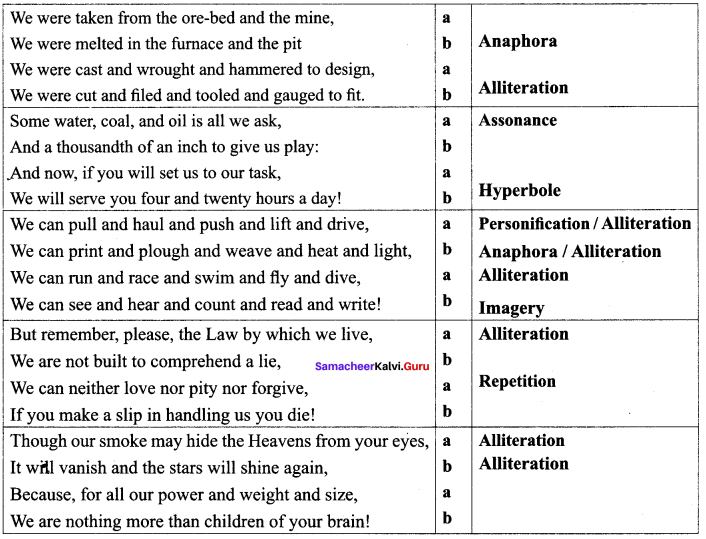
The Secret Of The Machines by Rudyard Kipling About the Poet:
A noble prize winner at 42, Rudyard Kipling was born on December 30, 1865, in Mumbai, India. He was educated in England but returned to India in 1882. He was fascinated by the advance made in science and technology and mechanisation through the Historical Revolution. A decade later, Kipling married Caroline Baluster and settled in Brattle boro, Vermont, where he wrote The Jungle Book (1894), among a host of other works that made him successful. Kipling was the recipient of the 1907 Nobel Prize in I Literature. He died in 1936.
The Secret of the Machines Summary:
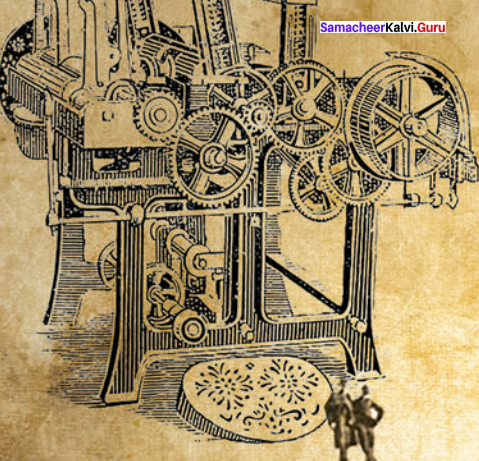
Introduction:
The poem by Rudyard Kipling deals with problems of technology and automation. The unquestioned utility of man-made inventions is highlighted.

Process of making machines
In the first stanza, the poet highlights the way machines are shaped and how they are managed. The raw material, iron- ore and minerals for machines are taken from the ores and mines accordingly. They were further melted in the blast furnace and in the mine. Metals were melted and turned into various designs using the hammer to be fashioned. They were also cut into different sizes and measured fit according to the required weight.
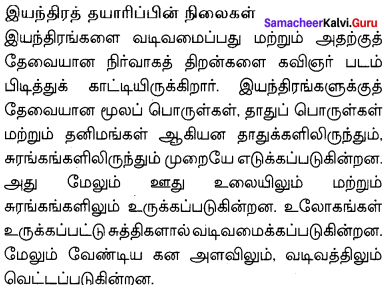
Machines:
Second stanza states that the only requirement for the machine is water, coal and oil. The moving parts may have a clearance of a thousandth of an inch which may be the permissible variation from the required dimensions. These parts are closely arranged with bolts and nuts leaving only less than an inch for the movement of wheels. With such a setup, the machines are willing to work round the clock, non-stop without any rest.
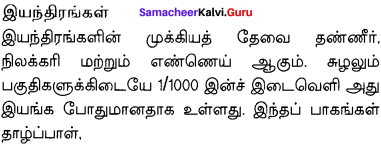

Machines reduce manual jobs:
In the third stanza, the machines elucidate how they can serve human race by doing all the possible human activities mastered by machines. They say they can do various tasks such as pulling, carrying, pushing, lifting, driving, printing, ploughing, weaving, heating, lighting, mining, racing, swimming, flying, diving, seeing, hearing, counting, reading and writing.
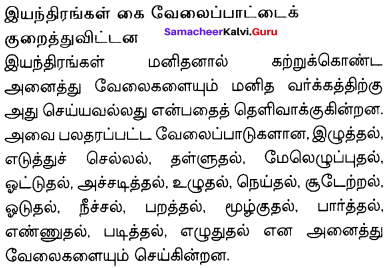
Friend indeed!
The machines in the fourth stanza caution the readers with an unshakeable moral imperative – the Law by which it Jives! The machines represent a form of absolute truth that is particularly difficult for mankind to understand. Here machines tell us that they don’t emote nor understand different feelings such as love, pity or apology. It reiterates its dangerous nature by simply stating that a slip while handling it means instant death.
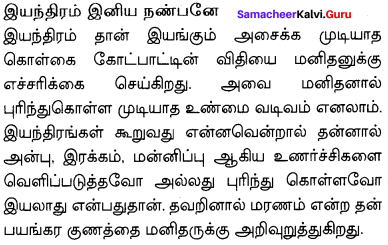
Man-made wonder:
In the last stanza the design of the machine just changes. The dream of the “perfect machinery” suddenly seems to fade out. Machines aren’t perfect. Nature always wins over. Machines aren’t miraculous creations but just a creation of the human brain. Therefore, machines although capable of great deeds, are still nothing more then creations of the human brain
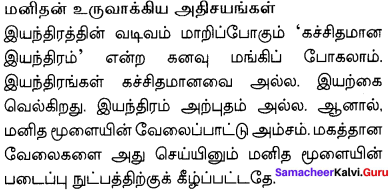
Conclusion:
The use of machines in everyday life has clearly established the fact that without them life comes to a standstill. Such is our dependence on machines which carry the instructions given by us. The perpetual use of machines in all fields shows the scalable heights it has reached.
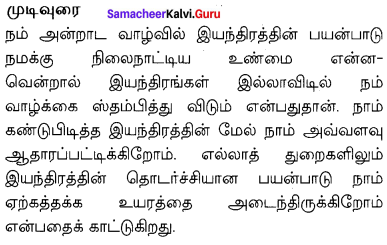
The Secret Of The Machines Glossary:
Textual:
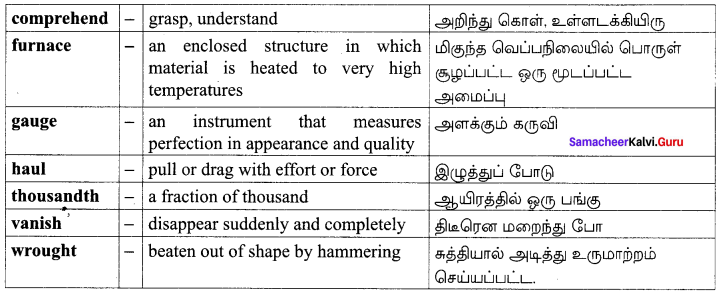
Additional:

We hope the data given here will benefit you to the fullest extent at the time of preparation. For better understanding of English subject this Samacheer Kalvi 10th English Solutions for Class 10th English Poem Chapter 5 The Secret of the Machines PDF is the best resource. Download & ace up your preparation. Keep in touch with us and get the latest information on Tamilnadu State board Textbook Solutions PDF.